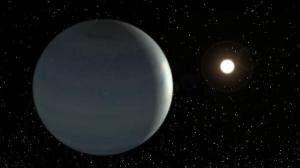First Temperate Exoplanet - Size of Jupiter - Discovered
An international team of scientists, including several who are affiliated with UC Santa Barbara, has discovered a new planet the size of Jupiter.
The planet, called CoRoT-9b, was discovered by using the CoRoT space telescope satellite, operated by the French space agency, The Centre National d'Études Spatiales, or CNES.
The newly discovered planet orbits a star similar to our sun and is located in the constellation Serpens Cauda, at a distance of 1500 light-years from Earth.
The European-led discovery involved 60 astronomers worldwide. The team included UCSB postdoctoral fellow Avi Shporer, who also works with the UCSB-affiliated Las Cumbres Observatory Global Telescope Network (LCOGT), based in Goleta, California. Three more LCOGT scientists - Tim Lister, Rachel Street, and Marton Hidas - also contributed.
"CoRoT-9b is the first transiting extrasolar planet that is definitely similar to a planet in our solar system, namely Jupiter," said Shporer. "What is special about this planet is that it transits a star, and it is a temperate planet. It has great potential for future studies concerning its physical characteristics and atmosphere."
The planet is mostly made of hydrogen and helium, but may contain up to 20 Earth masses of heavier elements including rock and water under high pressure. It thus appears to be very similar to the solar system's giant planets, Jupiter and Saturn.
A transit occurs when a celestial body passes in front of its host star and blocks some of the star's light. This type of eclipse causes a small drop in the apparent brightness of the star and enables the planet's mass, diameter, density, and temperature to be deduced. CoRoT-9b takes 95 Earth days to orbit its star. This is about 10 times longer than that of any planet previously discovered by the transit method.
The CoRoT satellite identified the planet after 150 days of continuous observation in the summer of 2008. The discovery of the planet was verified by ground-based telescopes. Those include the two-meter Las Cumbres Observatory Global Telescope Faulkes Telescope North (FTN), located on Mt. Haleakala on the Hawaiian island of Maui.
"Since a transit occurs only once every 95 days, FTN was at the right place at the right time to observe the transit in September 2009, thereby confirming the CoRoT detection," said Shporer.

"The planet, called CoRoT-9b, was discovered by using the CoRoT space telescope satellite. (Credit: Image courtesy of University of California - Santa Barbara)"
Source: University of California Santa Barbara
|